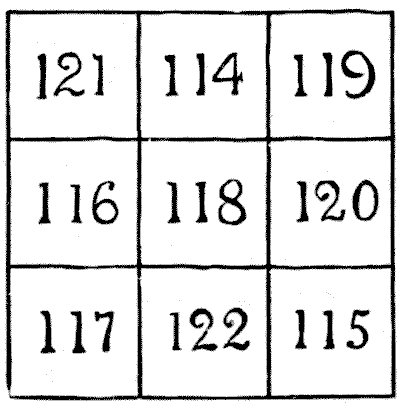
A MAGIC SQUARE OF COMPOSITES.—solution
The problem really amounts to finding the smallest prime such that the next higher prime shall exceed it by 10 at least. If we write out a little list of primes, we shall not need to exceed 150 to discover what we require, for after 113 the next prime is 127. We can then form the square in the diagram, where every number is composite. This is the solution in the smallest numbers. We thus see that the answer is arrived at quite easily, in a square of the third order, by trial. But I propose to show how we may get an answer (not, it is true, the one in smallest numbers) without any tables or trials, but in a very direct and rapid manner.

First write down any consecutive numbers, the smallest being greater than 1—say, 2, 3, 4, 5, 6, 7, 8, 9, 10. The only factors in these numbers are 2, 3, 5, and 7. We therefore multiply these four numbers together and add the product, 210, to each of the nine numbers. The result is the nine consecutive composite numbers, 212 to 220 inclusive, with which we can form the required square. Every number will necessarily be divisible by its difference from 210. It will be very obvious that by this method we may find as many consecutive composites as ever we please. Suppose, for example, we wish to form a magic square of sixteen such numbers; then the numbers 2 to 17 contain the factors 2, 3, 5, 7, 11, 13, and 17, which, multiplied together, make 510510 to be added to produce the sixteen numbers 510512 to 510527 inclusive, all of which are composite as before.
But, as I have said, these are not the answers in the smallest numbers: for if we add 523 to the numbers 1 to 16, we get sixteen consecutive composites; and if we add 1,327 to the numbers 1 to 25, we get twenty-five consecutive composites, in each case the smallest numbers possible. Yet if we required to form a magic square of a hundred such numbers, we should find it a big task by means of tables, though by the process I have shown it is quite a simple matter. Even to find thirty-six such numbers you will search the tables up to 10,000 without success, and the difficulty increases in an accelerating ratio with each square of a larger order.
click here to go to my blog.
See more interesting puzzles at http://puzzles.50webs.org